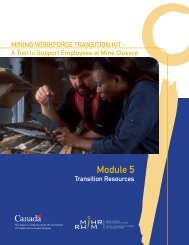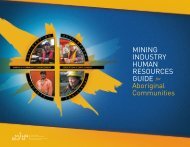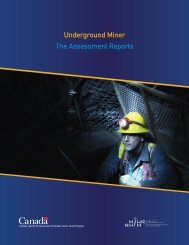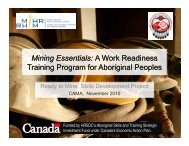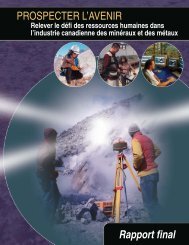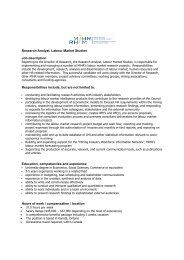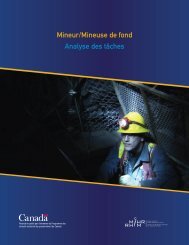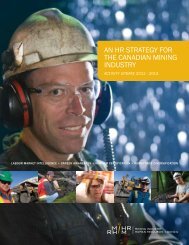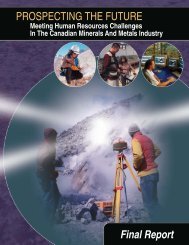Canadian Mining Industry Employment and Hiring Forecasts - MiHR
Canadian Mining Industry Employment and Hiring Forecasts - MiHR
Canadian Mining Industry Employment and Hiring Forecasts - MiHR
Create successful ePaper yourself
Turn your PDF publications into a flip-book with our unique Google optimized e-Paper software.
Immigrants to Canada — particularly those who are recently established — have typically had lower employment rates<br />
than the rest of the population. 22 What is more alarming is that unemployed recent immigrants also tend to have higher<br />
levels of education 23 than the rest of the unemployed population in the labour force. Many factors contribute to<br />
higher unemployment rates for immigrants, including lack of <strong>Canadian</strong> work experience; lack of recognition of foreign<br />
credentials or work experience; a preference to settle mainly in large urban centres; <strong>and</strong> language <strong>and</strong> cultural barriers.<br />
Nevertheless, mining employers are making great strides in attracting new <strong>Canadian</strong>s. Several approaches are<br />
producing positive results. Many employers are working to change perceptions among new <strong>Canadian</strong>s that mining is<br />
dirty, dangerous, <strong>and</strong> relatively “low tech.” Consequently, the industry is making efforts to improve new <strong>Canadian</strong>s’<br />
awareness about the work opportunities in the rural or remote areas where mining activities are typically located.<br />
Finally, employers <strong>and</strong> professional associations are working together to establish <strong>and</strong> improve on foreign-credential<br />
recognition programs <strong>and</strong> provide easy access to language training. This collaborative <strong>and</strong> integrated approach will<br />
ensure smooth transition <strong>and</strong> integration of new <strong>Canadian</strong>s into the mining labour market.<br />
Summary<br />
This chapter provided an economic overview of the <strong>Canadian</strong> mining industry <strong>and</strong> highlighted various labour market<br />
trends that impact the availability <strong>and</strong> quality of labour, including employment, turnover, productivity, educational<br />
attainment, compensation, labour relations, retirement projections <strong>and</strong> diversity.<br />
<strong>Employment</strong> in the sector is highly volatile, is directly related to commodity prices <strong>and</strong> is inversely related to gains in<br />
productivity. Paired with a rapidly aging workforce <strong>and</strong> lack of growth in the <strong>Canadian</strong> labour force, the sector will face<br />
significant challenges in the near future in finding the right talent to fill vacant positions.<br />
A two-faceted approach to meeting future workforce needs is recommended. First, industry employers are encouraged<br />
to make the best use of all available talent <strong>and</strong> continue with efforts to make mining an attractive option for talent<br />
groups such as women, Aboriginal peoples, new <strong>Canadian</strong>s <strong>and</strong> youth. Second, economic growth will come through<br />
improvements to productivity. To this end, employers should continue to make investments in workforce training <strong>and</strong><br />
development, <strong>and</strong> continue to support innovation <strong>and</strong> technological advances in the sector.<br />
22 Statistics Canada, 2009 Labour Force Survey Review.<br />
23 Statistics Canada, Study: Canada’s Immigrant Labour Market, Released in The Daily, September 2007.<br />
26 <strong>Mining</strong> <strong>Industry</strong> Workforce Information Network



